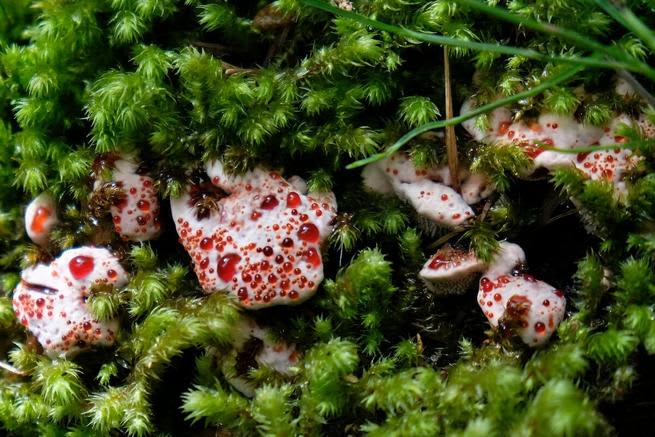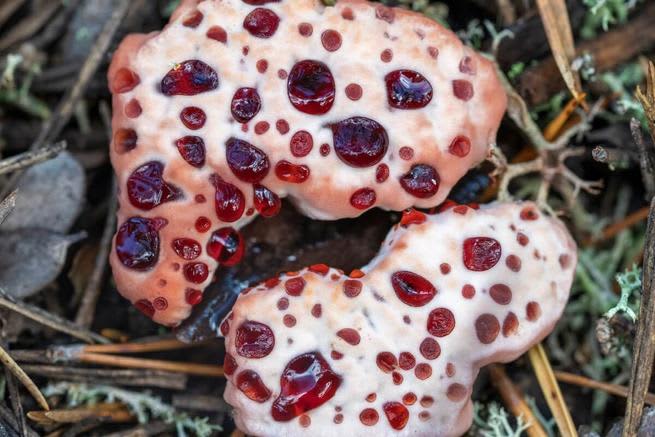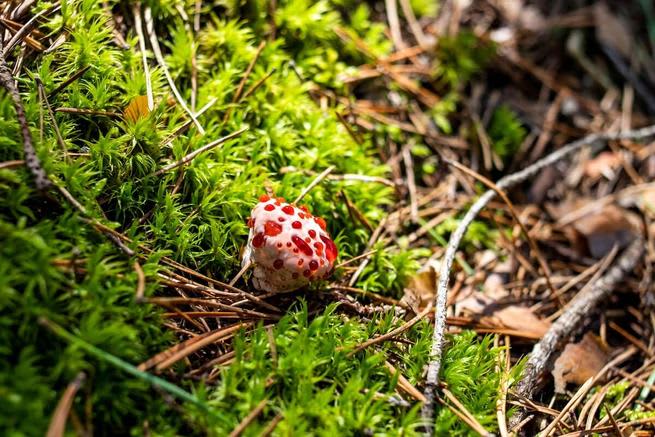

Picture yourself walking through a forest: you’re taking a calm stroll when you suddenly stumble across blood droplets on the ground. You take a closer look and, much to your horror, discover what looks like a set of teeth growing out of the earth?!
Well, luckily, no one was harmed there—the unique-looking bleeding tooth fungus has fooled mushroom lovers for centuries. Here’s what you need to know.
What is the bleeding tooth fungus?
The bleeding tooth fungus, scientifically known as Hydnellum peckii, is a mushroom species native to North America and Europe. Known for its unique appearance, H. peckii has become one of the most prized species by mushroom lovers looking for weird or unusual fungi.
Unlike most of the mushrooms we see in nature, the bleeding tooth fungus has an irregular cap that shows tooth-like projections on the underside. The cap is also dotted with red drops of a liquid known as guttation, giving it its famous “bleeding” look. However, the species also goes by other common names, such as (1):
- Bleeding Hydnellum
- Red-juice tooth
- Devil’s tooth
- Strawberries and cream
Another distinctive feature of H. peckii is its unrestricted and often unpredictable growth pattern. Unlike most fungi, this species can grow amorphously (without shape)—meaning it can grow around and even “swallow” objects in its vicinity! Tiny twigs and pinecones, for example, can sometimes be found at the heart of a fully-grown bleeding tooth fungus (2).
Despite looking similar to an edible pastry with strawberry jam, the species is considered inedible. While eating it won’t cause any side effects, it has an extremely bitter, peppery, and sometimes burning taste and a tough cork-like texture (3).
How does Hydnellum peckii look?

Due to its amorphous nature, it’s hard to define a type H. peckii. The cap can measure anything between 2.5–15 cm (1–6 in), usually growing convex initially but flattening out as the mushroom ages.
The color varies significantly with age—young specimens show a white to pink cap, while older fungi slowly turn dark brown. The oozing blood-like drops are always present both in young and old specimens.
The spines are relatively short and initially white and pink, with older specimens showing purplish-brown ones. The stem or stipe is 0.5–7.5 cm (0.2–3 in) long, often being off-center compared to the cap due to the unrestricted growth pattern. The spore print is entirely brown (3).
What are the varieties of bleeding tooth fungus?

There aren’t any varieties, strains, or subspecies of the bleeding tooth fungus. This is rather rare among fungi—most species have at least one variety, even if it’s considered obsolete in modern times (4).
However, the name “peckii” is often used in other genera to describe entirely different species. Examples of this include Lactarius peckii, Russula peckii, and Butyriboletus peckii. As such, if you want to research the bleeding tooth fungi, make sure you’re specifically looking for Hydnellum peckii (5).
History of bleeding tooth fungus

Unfortunately, there aren’t any records documenting the history of Hydnellum peckii in ancient cultures. One would imagine that such a spooky-looking mushroom could have inspired thousands of folklore myths and legends—but none of them have reached our times.
In fact, the first mention of the species in literature dates back to 1913, when American mycologist Howard James Banker first described it. He named it “peckii” in honor of renowned mycologist Charles Horton Peck.
Peck is somewhat of a legend among mycologists—during the 19th and 20th centuries, he detailed over 2,700 American mushroom species. Yes, you read that right: 2,700 species. He was so devoted to mushrooms that he was known to bite and chew unidentified species to determine their toxicity (2).
At the same time, all the way across the Atlantic Ocean, Italian mycologist Pier Andrea Saccardo transferred the species to the genus Hydnum in 1925. A few years later, in 1956, Walter Henry Snell moved it over to the genus Calodon.
Oddly enough, the mycological community never widely accepted these two modifications to the species. Nowadays, both Hydnum peckii and Calodon peckii are considered to be synonyms of Hydnellum peckii—which has remained the official name for the species (4).
Health benefits of bleeding tooth fungus

There’s almost no literature regarding the possible medicinal benefits of H. peckii. The only properties we could find are all based on theories—so far, there haven’t been any trials or experiments done with bleeding tooth fungi.
Allegedly, H. peckii provides two potentially beneficial compounds: atromentin and thelephoric acid. According to preliminary research, the first one is a pigment with antimicrobial and anticoagulant properties. While these effects aren’t fully confirmed, they do make H. peckii a promising prospect for replacing anticoagulant medicines (such as heparin).
Thelephoric acid, on the other hand, is believed to inhibit an enzyme known as prolyl endopeptidase (PEP), which is suspected to play a role in deteriorating memory and learning-related neuronal compounds. As such, thelephoric acid could help manage specific neurodegenerative conditions, such as Alzheimer’s disease (2).
However, it’s essential to remember that these health benefits are far from being fully confirmed. If you want to take H. peckii (or any other mushroom) for medical reasons, make sure you check with a doctor first.
Where does bleeding tooth fungus grow?

The bleeding tooth fungus is primarily native to coniferous forests in North America and Europe. It’s particularly prevalent in the Pacific Northwest, including Oregon, Washington, and Idaho. However, recent reports indicate it can also proliferate elsewhere—mainly in Iran, Scotland, and Korea.
The mushrooms can grow alone or in smaller groups of a few specimens. It’s also possible to find it in larger groups and even clusters of specimens—although this is much less common. The fruit bodies tend to appear from late summer through fall.
Bleeding tooth fungi are mycorrhizal fungi—meaning they grow in a symbiotic relationship (mutually beneficial) with their host trees. They seem to prefer coniferous trees, such as pine, Douglas-fir, and fir trees. Experts often recommend looking for moss or pine needle litter on the forest floor to find bleeding tooth fungi (3).
What is ethical wildcrafting?
Ethical wildcrafting refers to harvesting natural resources like berries, herbs, nuts, and mushrooms without damaging the environment. Wildcrafting is often confused with foraging—the key difference is that wildcrafting refers to harvesting for medicinal purposes and foraging for eating.
Careless harvesting can damage an ecosystem but practicing ethical wildcrafting is a mindful approach that follows these few rules of thumb:
- Do some research before heading out, taking note of any possible poisonous or endangered lookalike species you may encounter.
- Try to get your hands on a field guide to better tell apart your desired species from other similar ones.
- Pick the fruiting bodies gently, saving scissors and knives for when absolutely necessary.
- Don’t overharvest. Take only what you need and don’t share patch locations with others.
- Ask permission from the landowner if you’re wildcrafting on private land.
- Check local laws and regulations regarding harvesting if you’re wildcrafting on public land.
As always, we recommend looking for harvesting groups in your area if you’re new to hunting mushrooms. Experienced fungi lovers will usually be more than happy to show you the ropes.
Is it safe to wildcraft for Hydnellum peckii?
No, it’s never 100% safe to eat wild mushrooms, no matter the species. Although bleeding tooth fungi are relatively unique-looking, there’s always the risk of accidentally picking the wrong species. For example, you may unknowingly harvest Hydnellum ferrugineum—a bleeding tooth lookalike known to be inedible.
Furthermore, wild fungi often carry toxins from the environment, often leading to gastrointestinal pain and discomfort. If you’re set on eating wild H. peckii, make sure you wash and cook them thoroughly.
How do you take bleeding tooth fungus?
There isn’t a set way of eating or taking bleeding tooth fungi. The bitter and peppery taste of the species is universally considered to be undesirable. As such, you’re not likely to find them at your local supermarket or neighborhood restaurant.
However, this doesn’t mean some people haven’t tried incorporating them into their culinary arsenal. But, as you can imagine, the species almost always ends up as an extremely bitter and harsh replacement for chilis.
Bleeding tooth fungus: Nature’s bloodstains
Bleeding tooth fungi are among the most unique-looking mushrooms you can come across in North America and Europe. Although they’re considered too bitter to eat, their irregular growth pattern and crimson details have fascinated mushroom lovers for hundreds of years.
If you want to discover other kinds of mushrooms, keep up on shroomer. We cover every kind of fungus, from choice edibles to other unique-looking species.
References
- Vera Stucky Evenson. “Hydnellum peckii Banker.” in Mushrooms of Colorado: And the Southern Rocky Mountains (1997): 168.
- Patrick DeFlorin. “Hydnellum peckii.” BioWeb (2012). http://bioweb.uwlax.edu/bio203/f2012/deflorin_patr/index.htm
- David Arora. “Hydnellum peckii.” in Mushrooms Demystified (1986): 627.
- Mycobank. “Hydnellum peckii.” (Last accessed October 11, 2023). https://www.mycobank.org/page/Name%20details%20page/74438
- Roger Phillips. Mushrooms & Other Fungi of North America (1991): 110, 150.


